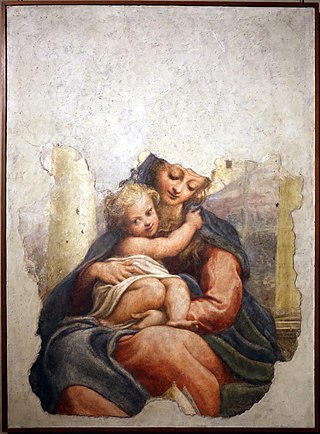
Parma is a city in the northern Italian region of Emilia-Romagna known for its architecture, music, art, prosciutto (ham), cheese and surrounding countryside. With a population of 198,292 inhabitants, Parma is the second most populous city in Emilia-Romagna after Bologna, the region's capital. The city is home to the University of Parma, one of the oldest universities in the world. Parma is divided into two parts by the stream of the same name. The district on the west side of the river is Oltretorrente. Parma's Etruscan name was adapted by Romans to describe the round shield called Parma.

Sisto Badalocchio Rosa was an Italian painter and engraver of the Bolognese School.

Antonio Allegri da Correggio, usually known as just Correggio was an Italian Renaissance painter who was the foremost painter of the Parma school of the High Renaissance, who was responsible for some of the most vigorous and sensuous works of the sixteenth century. In his use of dynamic composition, illusionistic perspective and dramatic foreshortening, Correggio prefigured the Baroque art of the seventeenth century and the Rococo art of the eighteenth century. He is considered a master of chiaroscuro.

Pietro Cavallini was an Italian painter and mosaic designer working during the late Middle Ages.

Girolamo Francesco Maria Mazzola, also known as Francesco Mazzola or, more commonly, as Parmigianino, was an Italian Mannerist painter and printmaker active in Florence, Rome, Bologna, and his native city of Parma. His work is characterized by a "refined sensuality" and often elongation of forms and includes Vision of Saint Jerome (1527) and the iconic if somewhat anomalous Madonna with the Long Neck (1534), and he remains the best known artist of the first generation whose whole careers fall into the Mannerist period.

Illusionistic ceiling painting, which includes the techniques of perspective di sotto in sù and quadratura, is the tradition in Renaissance, Baroque and Rococo art in which trompe-l'œil, perspective tools such as foreshortening, and other spatial effects are used to create the illusion of three-dimensional space on an otherwise two-dimensional or mostly flat ceiling surface above the viewer. It is frequently used to create the illusion of an open sky, such as with the oculus in Andrea Mantegna's Camera degli Sposi, or the illusion of an architectural space such as the cupola, one of Andrea Pozzo's frescoes in Sant'Ignazio, Rome. Illusionistic ceiling painting belongs to the general class of illusionism in art, designed to create accurate representations of reality.

Giovanni Lanfranco was an Italian painter of the Baroque period.

Cagli is a town and comune in the province of Pesaro e Urbino, Marche, central Italy. It is c. 30 kilometres south of Urbino. The Burano flows near the town.

Parma Cathedral is a Roman Catholic cathedral in Parma, Emilia-Romagna (Italy), dedicated to the Assumption of the Blessed Virgin Mary. It is the episcopal seat of the Diocese of Parma. It is an important Italian Romanesque cathedral: the dome, in particular, is decorated by a highly influential illusionistic fresco by Renaissance painter Antonio da Correggio.

The Assumption of the Virgin is a fresco by the Italian Late Renaissance artist Antonio da Correggio decorating the dome of the Cathedral of Parma, Italy. Correggio signed the contract for the painting on November 3, 1522. It was finished in 1530.

The Vision of St. John the Evangelist at Patmos (1520–1522) is a series of frescoes by the Italian late Renaissance artist Antonio Allegri da Correggio. It occupies the interior of the dome, and the relative pendentives, of the Benedictine church of San Giovanni Evangelista of Parma, Italy.

Giovanni Battista Vanni was an Italian painter and engraver of the Baroque period.

The Basilica of San Giacomo Maggiore is an historic Roman Catholic church in Bologna, region of Emilia Romagna, Italy, serving a monastery of Augustinian friars. It was built starting in 1267 and houses, among the rest, the Bentivoglio Chapel, featuring numerous Renaissance artworks.

San Giovanni Evangelista is a Mannerist-style, Roman Catholic church located on Piazzale San Giovanni, located just behind the apse of the Parma Cathedral, in the historic center of Parma, northern Italy. The buildings surrounding the piazza were also part of a former Benedictine convent. The church is notable for its Correggio frescoes.

The Santissima Annunziata, also called the Basilica del Paradiso, is a Renaissance style, Roman Catholic church and convent located on Via Massimo D'Azeglio in Parma, Italy.

The Camera di San Paolo or Camera della Badessa is a room in the former Monastery of San Paolo, in Parma, northern Italy. It is painted with frescoes by Correggio in the vault (697x645 cm) and over the fireplace.

The Madonna of the Stairs is a fresco fragment by the Italian Renaissance artist Correggio, dating to ca.1522–23 and now in the Galleria Nazionale di Parma.

Deesis with Saint Paul and Saint Catherine is an oil on panel painting by Giulio Romano, executed c. 1520, now in the Galleria nazionale di Parma. Its title refers to deesis, a subject in Christian iconography, shown here with Paul of Tarsus and Catherine of Alexandria in the lower register and the Virgin Mary and John the Baptist in the upper.

Mystic Marriage of Saint Catherine or Mystic Betrothal of Saint Catherine is a c.1524 oil on canvas painting by the Italian Renaissance painter Parmigianino. The work is now in the Galleria nazionale di Parma. Art historians argue that the work may be attributed to the period in which Parmigianino was painting his first works in the church of San Giovanni Evangelista, as also emerges from a recent restoration, which has shown that its technique is near-identical to that of Parmigianino - "no underdrawing, pigment use, descriptive speed, drafting of final shadows, using fingers and brush-ends as tools".

Pietà with Saints Clare, Francis and Mary Magdalene is a 1585 oil on canvas painting by Annibale Carracci, now in the Galleria nazionale di Parma.





















